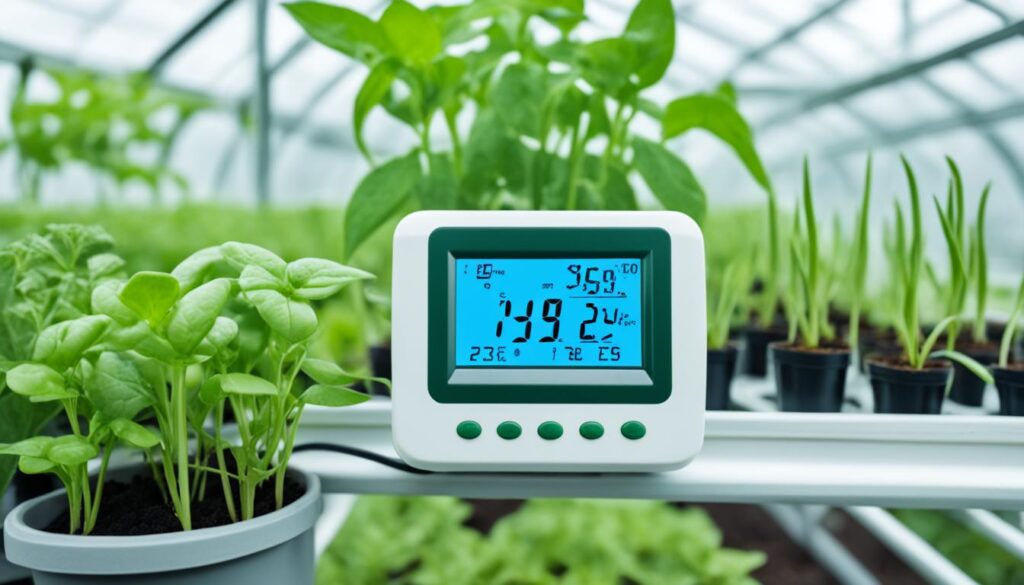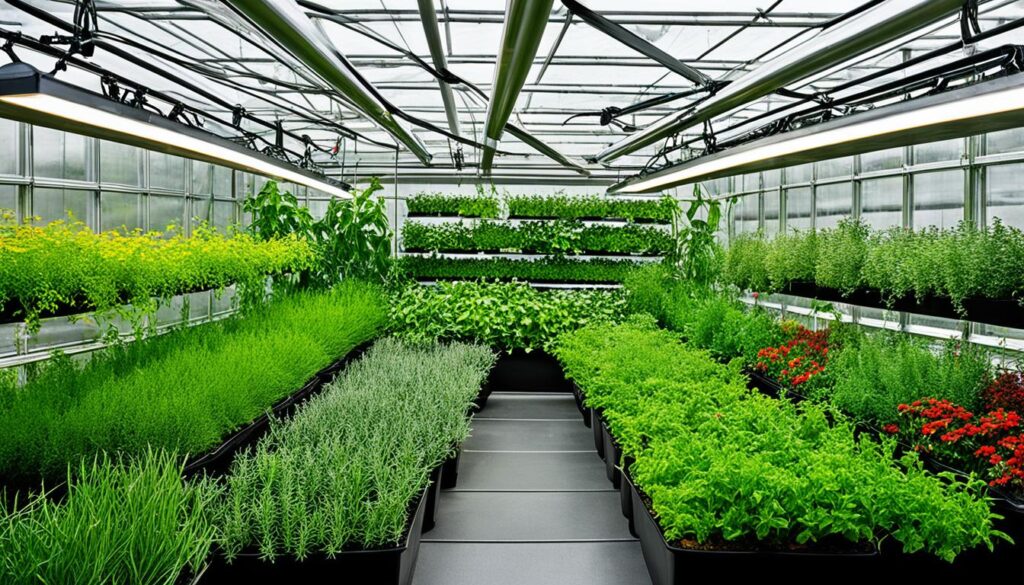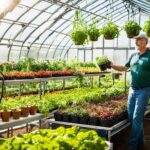Greenhouse Gardening: Extend Your Growing Season
Are you ready to unlock the secrets of year-round gardening? Greenhouse gardening could be the game-changer you’ve been searching for. By creating a controlled environment, greenhouses can extend your growing season by up to 60%. This lets you enjoy fresh produce long after your outdoor garden has gone dormant. But is this sustainable approach to gardening truly worth the investment?
Key Takeaways
- Greenhouse gardening can extend your growing season by up to 60%
- Greenhouses provide a controlled environment to protect your plants from harsh weather and pests
- Unheated and heated greenhouses both offer unique benefits for year-round gardening
- Hoop houses and row covers can further extend your growing season at home
- Greenhouse gardening allows you to grow a wider variety of plants, including herbs and annuals
Introduction to Greenhouse Gardening
Greenhouse gardening opens up new possibilities for extending your growing season and boosting your crop yields. It lets you create the perfect conditions for your plants to grow, no matter the weather outside. Whether you pick an unheated or heated greenhouse, the benefits are many and can change your gardening for the better.
Benefits of Using a Greenhouse
Growing in a greenhouse brings many benefits that can change your gardening. A greenhouse advantages include controlling temperature, humidity, and light for your plants. This controlled environment keeps your crops safe from pests, bad weather, and losing nutrients, leading to healthier, more productive plants.
Extending the Growing Season by Up to 60%
One big plus of greenhouse gardening is the chance to extend your growing season by up to 60%. By controlling the greenhouse temperature control, you can start seeds early in spring and keep harvesting into fall and winter. This lets you have a steady supply of fresh produce for longer, making your garden a year-round food source.
For both new and experienced gardeners, the perks of greenhouse gardening are exciting and motivating. Using a controlled environment helps you achieve new levels of gardening success. You get to enjoy the fruits of your labor for months, thanks to the power of a greenhouse.
Unheated vs Heated Greenhouses
Choosing between an unheated greenhouse and a heated greenhouse is key to your gardening success. It depends on your climate and what you want to grow. Knowing the good and bad of each type will help you pick the right one for your garden.
An unheated greenhouse uses the sun’s warmth to stay cozy. It’s a budget-friendly choice that works well in mild climates. You can grow many plants for a longer season. But, it might not let you grow plants all year like a heated greenhouse can.
Heated greenhouses let you grow plants all year, no matter the weather outside. This means you have more control over your plants. But, you’ll spend more on energy to keep it warm.
| Feature | Unheated Greenhouse | Heated Greenhouse |
|---|---|---|
| Climate Considerations | Suitable for milder climates | Suitable for a wider range of climates |
| Growing Season | Extended growing season | Year-round growing capabilities |
| Operating Costs | Lower energy costs | Higher energy costs for heating |
When deciding between unheated and heated greenhouses, think about your climate, what you want to grow, and your budget. Look at the climate considerations, cost comparison, and how much you want to extend your growing season. This will help you choose the best option for your gardening dreams.
At-Home Hoop Houses for Extended Growing
Gardeners looking for an affordable greenhouse can try at-home hoop houses. These are simple structures with frames and plastic coverings. They let you grow plants longer, starting early in spring and ending late in fall.
Hoop houses protect plants from rain, wind, and cold. They create a warm spot inside, making the growing season longer by up to 5 months. This means you can grow more fruits, vegetables, and herbs.
Growing Season Duration for Hoop Houses
Hoop houses are great for gardeners who want to grow more without spending a lot. They are a smart choice for season extension and cold weather protection. This makes them a cost-effective greenhouse option.
“Hoop houses are a great way for gardeners to extend their growing season without breaking the bank.”
For both new and experienced gardeners, adding a hoop house can change the game. With proper planning and care, these simple structures can give you a long harvest season.
Late Fall and Early Winter Harvests
Greenhouse gardening lets you keep harvesting into late fall and early winter. By moving cold-hardy veggies like carrots, spinach, and kale inside, you can get fresh produce long after the outdoor season ends.
The greenhouse’s warm and humid environment helps these tough crops grow even when it’s cold outside. This means you can keep enjoying late season harvests and taste the goodness of cold-hardy crops all winter.
Moving Plants Inside the Greenhouse
You can also bring potted plants and delicate herbs inside the greenhouse to keep them growing. The greenhouse microclimate is perfect for these plants, letting you have lovely flowers and fresh herbs all winter.
By relocating indoor plants to the greenhouse, they stay safe from harsh weather. This way, they keep thriving and give you lots of harvest even when it’s cold.
“Extending the growing season through greenhouse gardening is a game-changer, allowing me to enjoy a steady supply of fresh produce long after my outdoor garden has gone dormant.”
Year-Round Growing with Greenhouses
Gardeners looking to grow plants all year can use greenhouses and protection tents. These structures protect plants from bad weather and pests. They let tender plants grow even when it’s cold. Protection tents are a budget-friendly way to garden all year, perfect for many gardeners.
Protection Tents for Year-Round Gardening
Protection tents are smaller and easy to move, great for any backyard or patio. They offer the same benefits as big greenhouses, keeping plants warm and safe. These tents are perfect for growing tender crops or extending the season for herbs. They make year-round gardening easy and affordable.
- Protect plants from harsh weather conditions, such as frost, wind, and heavy rain
- Extend the growing season by up to 60% for many crops
- Affordable and space-efficient solution for small-scale gardeners
- Allows for the cultivation of year-round vegetables, herbs, and flowers
Using protection tents lets gardeners get more from their gardens and enjoy greenhouse season extension all year. With some effort and care, you can make a beautiful, year-round garden in your backyard.
Monitoring Greenhouse Temperature
Keeping the right temperature in your greenhouse is key for your plants’ health and growth. If the temperature changes too much, your plants might grow slow, get sick, or even die. So, it’s important to watch the temperature closely and adjust it as needed to help your plants do well.
Importance of Temperature Monitoring
Thanks to modern tech, like remote monitoring and digital sensors, it’s easy to keep an eye on your greenhouse’s temperature and humidity. By watching these levels closely and making changes when needed, gardeners can make sure their plants get the best conditions. This helps plants stay healthy all season long.
- Maintain optimal greenhouse temperature control for healthy plant growth
- Detect and address temperature fluctuations quickly with temperature monitoring solutions
- Utilize remote monitoring technologies to track conditions from anywhere
- Adapt growing practices to provide the perfect environment for your plants
By keeping an eye on your greenhouse’s temperature and adjusting it when needed, you can grow plants longer and get more from your garden. With the right tools for monitoring, you can make your greenhouse the perfect place for your plants to flourish.

“Consistent temperature monitoring is the key to unlocking the full potential of your greenhouse gardening.” – Gardening Guru, Jane Doe
Floating Row Covers for Plant Protection
Row covers are a big deal for greenhouse gardening. They’re lightweight and let air and light through. This gives your plants an extra shield against cold snaps and pests. Adding row covers to your greenhouse setup helps your plants grow longer and stay safe.
Row covers are great for protecting against frost. In spring and fall, they keep seedlings and crops warm. Even in cold winters, the right row covers keep plants healthy and growing.
Row covers do more than just fight frost. They also keep insects, birds, and pests away from your plants. This means less damage and disease, leading to a bigger harvest.
If you want to improve your greenhouse gardening, think about using row covers. They offer many benefits, like protecting against frost and pests. These tools can make your plants last longer and grow better all season.
“Floating row covers are a must-have for any greenhouse gardener who wants to push the boundaries of their growing season.”
Transitioning to Outdoor Summer Growing
As the growing season moves forward, gardeners should think about moving some plants from the greenhouse to the outdoors. This shift makes the greenhouse more efficient. It also opens up space for more summer harvest crops.
When moving plants outside, it’s important to acclimate them gradually. This means starting with a little outdoor time and slowly adding more. This helps the plants get used to the sun and changing temperatures without shock.
Moving plants outside in the summer can boost their growth and yields. This means a bigger summer harvest for you. Using both the greenhouse and outdoor space can make your garden more efficient.
“Transitioning plants outside is like introducing a friend to a new environment – it takes time, patience, and care to ensure a smooth adjustment.”
The aim is to balance the greenhouse and the garden. This way, you make the most of your space all summer.
| Benefits of Transitioning Plants Outdoors | Considerations for Outdoor Acclimation |
|---|---|
|
|
Extending the Life of Annual Herbs
Greenhouses are great for making annual herbs like basil and cilantro last longer. These herbs are hard to grow all year in cold places. With a greenhouse environment that controls temperature, gardeners can have fresh herbs all year.
In a greenhouse, these delicate annual herbs do well. Gardeners can pick their favorite herbs from fall to winter. This way, they can enjoy fresh, tasty herbs all season long.
Using Greenhouses for Herb Growth
Greenhouses are perfect for growing herbs all year. They let gardeners keep their favorite herbs going even when it’s not the right time outside. Inside, plants are safe from bad weather. They get the right amount of light, temperature, and humidity to grow well.
| Herb | Outdoor Growing Season | Greenhouse Growing Season |
|---|---|---|
| Basil | Summer | Year-round |
| Cilantro | Spring to Fall | Year-round |
| Parsley | Spring to Fall | Year-round |
Using a greenhouse lets gardeners keep their annual herbs going all year. They can have a lot of herbs, no matter the weather outside.

Greenhouse Gardening: Crop Choices
When planning your greenhouse garden, think about the crops that do well in the controlled space. Choose cold-hardy veggies like carrots, beets, and bunching onions for early planting. They handle cooler greenhouse temperatures well.
Later in the season, grow a variety of crops such as tomatoes, peppers, and cucumbers. For the best results, prepare the beds well. Till the soil 8-12 inches deep, add soil amendments, and cover rows with row covers to fight weeds before planting.
Preparing Greenhouse Beds for Planting
Choosing the right crops and preparing the space well can boost your greenhouse garden’s success. Here are steps to prepare your beds:
- Till the soil 8-12 inches deep for better root growth and air flow.
- Add organic stuff like compost or manure to make the soil richer and more fertile.
- Use row covers or mulch to keep weeds down and soil moist.
- Check the soil’s pH and adjust it if needed for your crops.
| Crop | Ideal Temperature Range | Ideal Soil pH |
|---|---|---|
| Tomatoes | 70-85°F | 6.0-6.8 |
| Peppers | 65-85°F | 6.0-6.8 |
| Leafy Greens | 55-75°F | 6.0-7.0 |
Plan your greenhouse crops and prepare your beds well. This way, you can have a thriving garden that grows more food for longer.
“Greenhouse gardening lets me grow more crops and extend my growing season. The key is to pick the right crops and prepare the beds right.”
Greenhouse Gardening Techniques
Greenhouse gardening needs special techniques for the best plant growth. Start with preparing your beds well. This means tilling the soil, adding nutrients, and using row covers to keep weeds away. It’s also key to think about ventilation, temperature, and moving plants between the greenhouse and outside.
To make the most of your greenhouse, use special planting methods. Start seeds indoors, move seedlings to the greenhouse, and manage temperature and humidity. Preparing your beds and optimizing conditions lets you grow more, longer, and enjoy fresh produce all year.
Preparing Greenhouse Beds for Planting
Before planting, make sure your beds are ready. Till the soil, add compost or manure, and use row covers for weeds. This makes a healthy, weed-free place for your plants to grow.
- Till the soil to a depth of 6-8 inches, breaking up any compacted areas.
- Mix in 2-4 inches of compost or other organic amendments to improve soil structure and fertility.
- Use floating row covers to block light and prevent weed growth between plantings.
Optimizing Greenhouse Conditions
Managing temperature, humidity, and ventilation is also crucial. This might mean using climate control systems, checking conditions, and adjusting as needed.
- Install a reliable thermometer and hygrometer to track temperature and humidity levels.
- Ensure adequate ventilation to prevent stagnant air and maintain proper air circulation.
- Utilize supplemental heating or cooling systems to maintain the ideal temperature range for your crops.
Using these greenhouse gardening tips, you can make the most of a protected space. This leads to a longer season, more produce, and fresh, quality food. With some knowledge and care, your greenhouse can be a thriving place for your plants.
“Greenhouse gardening allows me to grow a wider variety of crops and extend my growing season by several months. The extra control over environmental factors has been a game-changer for my home garden.”
– Sarah, Experienced Greenhouse Gardener
Conclusion
Greenhouse gardening opens up new chances for gardeners to grow more and longer. It lets you control the environment, making it perfect for many plants. You can grow everything from hardy veggies to delicate herbs and flowers.
Choosing between an unheated or heated greenhouse, or even a cheaper hoop house, changes everything. You can control the temperature, humidity, and light. This means you can grow food into late fall and early winter.
By watching the greenhouse conditions and using things like row covers, you can make a garden that grows all year. With some effort and the right methods, greenhouse gardening can change the game for all gardeners. It opens up new possibilities in your backyard.
Greenhouse gardening is full of potential. It lets you grow more, try new plants, and have a garden all year. If you’re starting or want to improve your gardening, this article has tips to help. It can make your greenhouse gardening successful and rewarding.
FAQ
What are the benefits of using a greenhouse?
What’s the difference between an unheated and a heated greenhouse?
How can at-home hoop houses extend the growing season?
How can greenhouses help extend the late fall and early winter harvests?
How can greenhouses and protection tents enable year-round gardening?
Why is it important to monitor greenhouse temperature?
How can floating row covers provide additional plant protection?
When should plants be transitioned from the greenhouse to the outdoor garden?
How can greenhouses help extend the life of annual herbs?
What should gardeners consider when planning their greenhouse crops?
Source Links
- https://mrcrazykicks.com/how-much-can-a-greenhouse-extend-the-growing-season/ – How Much Can a Greenhouse Extend the Growing Season?
- https://sunshinegreenhouse.com/blogs/sunshine-greenhouse-kit-blog/using-a-greenhouse-to-extend-the-growing-season – Using a Greenhouse to extend the growing season
- https://www.new-terra-natural-food.com/growing-plants-in-a-greenhouse.html – Growing plants in a greenhouse to extend your growing season
- 10 Must-Have Blooms for Your 2025 Garden
- The Health Advantages of Gardening You Need to Know
- How to Create a Small Vegetable Garden Layout Plan: A Beginner’s Guide
- DIY Garden Projects for Small Spaces: Upcycling Ideas to Maximize Your Garden
- Watering Techniques for Small Gardens: Ensuring Your Plants Thrive
- Small Border Plants for Landscaping: Adding Beauty and Functionality to Your Garden
- Year-Round Small Space Gardening: Seasonal Planting Tips for Maximum Harvest
- Essential Tools for Small-Space Gardening: What You Really Need
- The Ultimate Guide to Container Vegetables: What to Grow in Small Spaces
- Budget-Friendly Gardening: How to Create a Thriving Garden on a Tight Budget
- How to Optimize Sunlight in Small Gardens: Tips for Better Plant Growth
- DIY Vertical Planters: Creative Ideas for Small Space Gardening
- Companion Planting for Small Vegetable Gardens: Boost Growth and Deter Pests
- Container Gardening Essentials: Choosing the Right Pots, Soil, and Plants
- Vertical Gardening Techniques: Maximizing Your Small Space with Climbers and Vines
- How to Build a Raised Bed Garden in a Small Backyard: Step-by-Step Guide
- The Best Vegetables for Small-Space Gardens: High-Yield Varieties You Need to Grow
- Smart Vegetable Garden Layouts for Small Spaces: Maximizing Your Green Thumb in Compact Areas
- 40. Best Practices for Managing a Sustainable Garden Year-Round
- Building a Wildlife Pond for Biodiversity
- Advanced Techniques in Sustainable Gardening
- How to Create a No-Till Garden
- The Mental Health Benefits of Gardening
- Using Technology to Enhance Sustainable Gardening
- Getting Certified Organic: Steps and Benefits

Leave a Reply